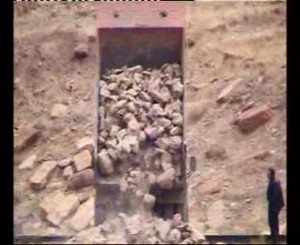 Image: Armine Minassyan, 19, holds the Armenian flag during rally after thousands of American Armenians marched in the Hollywood section of Los Angeles Thursday April 24, 2008, to observe the 93rd anniversary of the Armenian genocide. The marchers want the Turkish government to admit responsibility for the slaughter of about 1.5 million people during World War I. (AP Photo/Kevork Djansezian)
Image: Armine Minassyan, 19, holds the Armenian flag during rally after thousands of American Armenians marched in the Hollywood section of Los Angeles Thursday April 24, 2008, to observe the 93rd anniversary of the Armenian genocide. The marchers want the Turkish government to admit responsibility for the slaughter of about 1.5 million people during World War I. (AP Photo/Kevork Djansezian)
 Image: A woman attends a religious service marking the the Armenian Genocide anniversary at an Armenian church in Tbilisi April 24, 2008. REUTERS/David Mdzinarishvili (GEORGIA)
Image: A woman attends a religious service marking the the Armenian Genocide anniversary at an Armenian church in Tbilisi April 24, 2008. REUTERS/David Mdzinarishvili (GEORGIA)
Ninety-three years after the Armenian Genocide started Armenians still remember their unforgettable tragedy. Ninety-three years after the extermination of western Armenia started Turkey denies it ever happened. Ninety-three years after the Genocide started it continues for many Armenians. It continues in denial, hatred and continuous oppression of Armenian culture in Turkey.
For Armenians, April 24 is a day of sorrow, reflection and pride. Sorrow for the uncountable lives lost and an ancient culture reduced to dust; reflection on how to deal with the past in the present for a better future; and a pride for surviving the worst crime in this world.
For Turks, it is a story rather to remain untold. Challenging Turkey’s very right to exist, the Genocide is seen a threat to national pride and legitimacy by many Turks. But for others, it is also a fundamental question of human rights with universal and apolitical applications.
 BBC IMAGE: Turks commemorating Gallipoli on April 24, 2008
BBC IMAGE: Turks commemorating Gallipoli on April 24, 2008
The conventional Turkish attitude was reflected in a large event in Turkey. According to the BBC, “Turkish soldiers, members of the traditional Ottoman army band of Mehter, perform[ed] …during the 93rd anniversary of the World War I campaign of Gallipoli.” The battle of Gallipoli, according to Wikipedia, “is perceived as a defining moment in the history of the Turkish people—a final surge in the defense of the motherland as the centuries-old Ottoman Empire was crumbling.” The Turkish understanding of Gallipoli has been extended to nationalist attitude toward the Genocide. The few who proudly admit they committed the crime, argue it was for the sake of saving Turkey.
For Armenians, the Genocide was not an act to save the Ottoman Empire but to expand the Turkish leadership’s imperialist desire of establishing a Pan-Turkish empire from the Balkans to China. The Armenian nation, according to many Armenians, was the obstacle to expansion. They held the keys to the frontier.

BBC IMAGE: Message for peace at the Armenian Genocide Memorial in Yerevan
In Armenia, hundreds of thousands of people visited the Genocide memorial in the capital city Yerevan. Some had brought pigeons for peace (as seen in the picture above), while another brought a Turkish flag to step on. Interestingly, Turkey’s nationalist Sabah newspaper was quick to report the latter.

Image: Tsitsernakaberd, Yerevan, Armenia © Onnik Krikorian / Oneworld Multimedia 2008
But another Turkish newspaper, Taraf, devoted its front page to the Armenian Genocide yet was careful not to use the word genocide. (I received the .pdf version in an e-mail from Turkey and its English translation from a Turkish friend in California.) It published the names of the Armenian intelligentsia members who were arrested and eventually killed on April 24, 1915. Taraf’s article was nothing close to recognition or acknowledgment, but given the high degree of ultra-nationalism in Turkey it was indeed a progress. In fact, a dangerous one too. A Kurdish newspaper, for example, was closed down after publishing photographs from a possible Armenian mass grave in 2006 (later cleaned up by the Turkish army and presented by the Turkish historical society as a Roman cave).
But like the Armenians who have survived the Genocide, the closed Kurdish newspaper continues to publish… under another name. Its website is now http://www.aktuelbakis.com/ and it just published another story on the Armenian Genocide.
Outside Armenia and Turkey, the Genocide was also commemorated. In Southern California – the largest Armenian hub outside the Republic of Armenian – thousands joined hands in marching for genocide recognition. Also in the U.S., the White House released a statement by President George W. Bush commemorating the Armenian Genocide in another failure to refer to the Genocide as such. In the meantime, House Speaker Nancy Pelosi talked of the importance of recognizing the Genocide in a video posted at YouTube.com. In Lebanon, another Armenian diaspora, people came together to pray for the dead ones.
Conventional and unconventional media remembered the Genocide as a blow to Hitler’s reference that the Armenian extermination is forgotten. Agence France Press wrote about the commemoration in Yerevan posting a map of the areas where Armenians lived before 1915. The National Geographic Magazine posted a map of Wilsonian Armenia, the territory given to the Armenian nation under the Treaty of Sevres (1920) with a short history on the Genocide. The World War 4 Report, a website for indigenous rights, wrote about the Armenian Genocide and its argued connection to Artsakh – Nagorno Karabakh.
In one place, the message of the Armenian Genocide anniversary was summarized in a few words: no nation is above global justice.

Image: Arpa Sinanian, 3, sitting on top her father’s shoulders holds a sign during a rally after thousands of American Armenians marched in the Hollywood section of Los Angeles Thursday April 24, 2008. (AP Photo/Kevork Djansezian)



 Image:
Image:  Image:
Image:  BBC IMAGE: Turks commemorating Gallipoli on April 24, 2008
BBC IMAGE: Turks commemorating Gallipoli on April 24, 2008 


